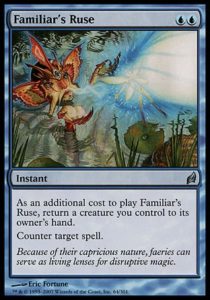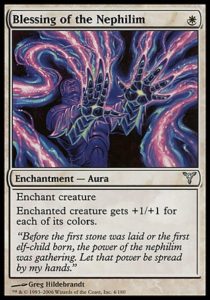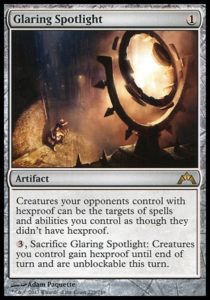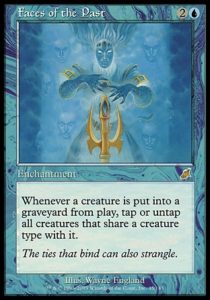This Fall, we return to Ravnica for a second time. This will be the first re-revisiting of a modern set; only Dominaria has been home to 3+ blocks (discounting core sets). Ravnica is among Magic’s most popular worlds. Returning there is not only inherently exciting, it’s also the culmination of the last several years of storytelling. We’ll finally see Bolas’ plans come to fruition and the Gatewatch reunite after their defeat on Amonkhet.
One might think that revisiting a popular and thoroughly established plane would be easy for Wizards, but Ravnica presents a series of challenges. Today, let’s consider the challenges both of revisiting any world, as well as those specific to Ravnica.
Balancing Familiarity and Novelty
Every world has certain essential traits. In terms of thematic design, Ravnica is a massive, single-city world with Slavic architecture and ten two-color guilds. Mechanically, Ravnica is home to guildmages, color-fixing artifacts and lands, legendary leaders of each guild, a minimum of ten mechanics, and possibly the Shocklands (though I wouldn’t be surprised if they don’t return this time). Returning to a Ravnica without these qualities would be akin to returning to an horror-less Innistrad or a Zendikar without hedrons.
At the same time, there needs to be sufficient innovation so that the world feels fresh, rather than a retread of everything seen before. In order to make room for the new, many things are cut. Some cycles are intentionally not revisited; the spell-creatures (Patagia Viper and friends), the Magemarks, the Nephilim, the Gateless, the hybrid one-drops and “can’t be countered” cycles and more only appeared in some Ravnican sets. Some parts of the world change, such as the Simic Combine gaining wild creature combinations like Shambleshark and Crocanura or the Rakdos becoming more entertainment-focused than merely murderous cult. Everything has its fans, but most of the old has to be set aside for new mechanics, new cycles, new forms of fixing, and a new story. The focus has to be kept on what’s essential to the world: the guilds. (Some things, like the Gateless movement from RtR Block was more of a distraction from the focus of the world than a strong innovation.)
Or to put it another way, there are going to be barely any reprints from previous Ravnica sets, so there’s got to be an enormous amount of new stuff, but it all has to feel contiguous with what came before.
Five Rigid Archetypes
The inherent problem of Ravnica Limited is the number of options. The average set supports all ten colors pairs. They are never equally strong, but there’s ample self-correction as long as they’re all playable. Ten color pairs provide ten options to eight drafters, enough to allow most players, if not everyone to be in different color combinations.
Archetypes run into problems as options diminish. In Battle for Zendikar Limited, green was essentially unplayable, meaning that there were only six viable color combinations. When eight players compete for six decks, it’s harder for people to get the cards they want, read signals, and have playable decks. This problem was perhaps at its worst in triple Ixalan, where there were only four tribes. Yes, there were theoretically eight viable color combinations (every color combination other than WU and BG was in a tribe), but the best decks relied on tribal synergies which were both small in number and mostly worthless outside of their color combinations. If you were in GU and recognized that Merfolk wasn’t open but UB Pirates was, changing colors wouldn’t just involve you discarding your green cards, it would also invalidate your best blue cards as well. This was exacerbated by the format’s low average power level. In a Masters format full of strong, playable commons, you can jump ship in pack two and still have a playable deck, but in Ixalan, you might only have seventeen cards you were happy to play. Limited formats with fewer than eight viable options are often worse formats.
Ravnica has this problem in spades. Because of the strong focus on guilds, you’re rarely rewarded for drafting one of the five unsupported color combinations and there isn’t always a plethora of synergy between guilds. If you were drafting Boros in Gatecrash and realized it was overdrafted in pack two, you had three options: jump into Gruul, jump in Orzhov, or tough it out in Boros. Drafting Azorius or Selesnya weren’t options. Sets with fewer color combinations have fewer options and are less forgiving if you’re in the wrong colors. They do compensate for this by having a greater density of cards in those colors (accommodating multiple drafters in each color combination), but it can harm a format’s longevity.
Ravnica: City of Guilds block had neat puzzle, where the guilds you drafted opened up different options for tricolor decks. For example, if you started in Dimir, you could either go into Izzet in pack 2 and Rakdos in pack 3, or go into Orzhov in pack 2 and Azorius in pack 3. This does have serious issues for less experienced drafters who aren’t in the know, but it was very cool at the time. We will definitely not be going down this road again in Guilds of Ravnica or Ravnica Allegiance (because of the Blockless Paradigm), and given how overstuffed Dragon’s Maze had to be to fit all ten guilds in (that set was super informative from a design side and was likely impossible to execute perfectly, given the immense load it had to bear), I suspect we probably shouldn’t ever see a Ravnica with all guilds crammed into a single set.
Equal Density, Unequal Time
Ravnica: City of Guilds couldn’t fit all ten guilds into its one large set, so the four guilds in the first set received both more cards and more time in the Standard spotlight than the Azorius Senate, Cult of Rakdos, and Simic Combine (which were featured last, in Dissension). Return to Ravnica block addressed the former issue but not the latter, and Guilds of Ravnica continues this trend: some color combinations are just going to be relevant in Standard three months earlier and longer.
This is a minor quibble, but it’s a necessary consequence of how sets are designed. One can’t shove all ten guilds with ten new mechanics and seven ten-card cycles into a set. If they have to be spread out, something has to come first. And as we’ve seen recently, increasing the number of Standard rotations is bad for Magic.
This point is a minor nitpick, but a real one: every guild is a lot of peoples’ favorites, and everyone wants their guild to be highlighted more than the rest.
A Familiar Allotment
A final and tiny nit: the guild allocations of Guilds of Ravnica and Ravnica Allegiances feel a bit weird. Guilds of Ravnica features a familiar combination: the four guilds of Ravnica: City of Guilds plus Guildpact’s Izzet League. While Return to Ravnica and Gatecrash juxtaposed different guilds than we’d seen before (and there are other ways to combine the guilds that aren’t 4-1, like WU, UB, RG, BG, RW & BR, GW, WB, UR, GU), Guilds of Ravnica will have to work a bit harder to make four guilds that have already played with each other do so differently.
And that’s the design considerations of Ravnica in a nutshell. It’ll be exciting returning to one of my favorite plans, see the reunion between Jace and Captain Vraska (one of my favorite stories Magic has ever done), and also see a massive conflict upon Ravnica—a plane which had an entire block dedicated to mostly restoring it status quo.
And, as always, thanks for reading!
—Zachary Barash
Zachary Barash is a New York City-based game designer. He works for Kingdom Death: Monster, has a Game Design MFA from the NYU Game Center, and does freelance game design. When the stars align, he streams Magic.
His favorite card of the month is Ghitu Chronicler. For two mana less than Archaeomancer, you get a Straw Soldiers. For two mana more, you get an Archaeomancer with one extra point of toughness. Somehow, the combination of these two components yields a more powerful card than the more straightforward one. It all goes to show how powerful flexibility and Kicker are. …unless you’re playing Ghostly Flicker, then everything I just said is wrong.





